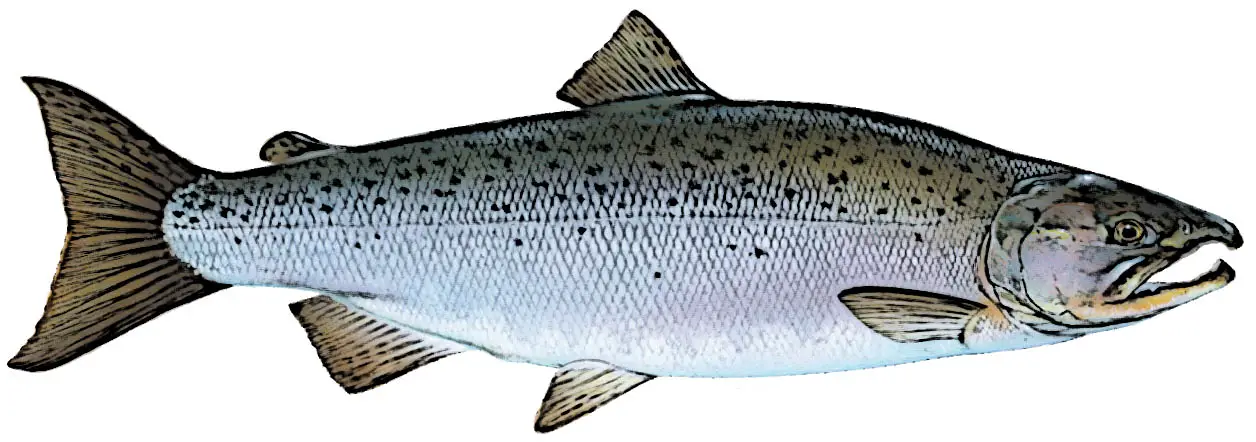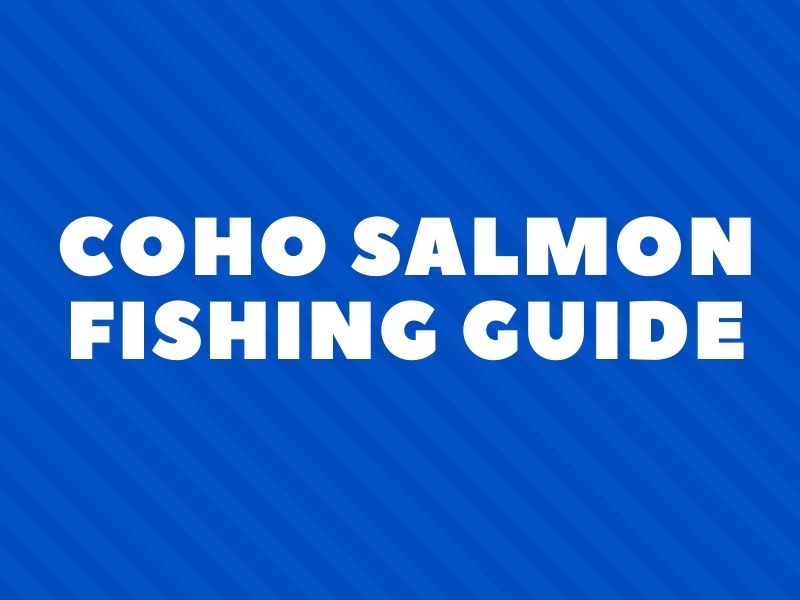Coho salmon also referred to as silver salmon or “silvers” are a popular fish to target in the western regions of the United States and throughout the great lakes region. They can be fished from California all the way up to Alaska, where coho is one of the most prized game fish in the region. If you’re going after coho salmon, you need to read this guide. We will cover everything you need to know about the species, where to fish for them, the equipment you will need, and give a few additional tips to help you catch more coho.
Coho Salmon Identification
Coho salmon are a member of the pacific salmon family. They are known for having white gums and black tongues. They can be a silver color or a red to wine color depending on their age and whether they are male or female. Their back and heads are usually a dark blue-green color.

Most salmon that you will catch will weigh an average of around 5 to 15 lbs and be around 17 to 24 inches in length. Larger coho salmon can reach sizes up to 38 inches and weigh upwards of 30+ lbs.
Where to Catch Coho Salmon
Coho can be caught throughout the United States. They can be fished throughout the great lakes and have been introduced to many reservoirs, but they are most popularly fished along the sides of the North Pacific Ocean from California to Alaska.
Coho are anadromous, so they can survive in both freshwater and saltwater. They usually spawn in rivers and migrate to saltwater to feed and grow, returning once again to freshwater for spawning.
If you’re trying to locate salmon in rivers a lot of times you will be targeting them when they swim upstream to spawn. They usually travel close to the bottom, close to shore, in areas with slower currents. Fish around gravel, rocks, bends, and turns, anything that can slow the current and make the travel easier.
You can also catch coho salmon in deeper pools with no current. Look behind back eddies, bends, channels, and structure. These are areas the salmon may hold and relax before they continue their upstream journey.
What Do Coho Salmon Eat?
Younger coho salmon tend to eat insects but as they mature and move out to saltwater areas they will eat herring, pilchards, crustaceans, squid, jellyfish, and other fish species. Coho in the great lakes are known for feeding on smelt and alewives.
Seasonal Patterns
Fall
In early fall to early winter, coho salmon begin to make their spawning runs, depending on the location you are in. They return to the freshwater streams they were born in to spawn. If you’re fishing the spawning run, they can be caught in coastal streams as they swim their way upstream. They like to spawn in smaller streams with gravel bottoms.
Winter
In the wintertime, coho can be readily caught in small rivers and streams. The mouths of coastal rivers tend to be productive places to fish. You can also catch them near harbor mouths. Look for areas that have an influx of warmer water and are full of baitfish. In the great lakes regions, deeper offshore sites with 150+ feet of water are good places to look as well.
Spring
When the water starts to warm up in the springtime, certain pockets of lakes warm up faster and begin to teem with baitfish activity. This is where you will catch coho hunting. Later in the spring they will move offshore.
Summer
In the summer coho salmon are usually looking for deeper cooler waters. Fish areas ranging from 50 feet to 300 feet deep. As always, the areas with a lot of baitfish are the likely places you will find the coho. Coho prefer to hunt looking up, so when you find a pocket of baitfish, the salmon will be below them.
Coho Salmon Equipment Recommendations
Rods and Reels
Both spinning gear setups and conventional rods and reels are popular choices for fishing coho. Some anglers even carry multiple rods for things like twitching jigs and other tactics. We recommend a medium to heavy rod with moderate to fast action
If you’re using a spinning rod and reel, an 8’ 6” to 9’ 6” length rod is a good bet. Make sure you choose a reel that can handle 100 yards of 10-15 lb test line.
If you’re after larger coho salmon a conventional rod and reel might be your best choice. Again around 8’6” to 9’6” in length. Though you can go shorter if needed.
Lures and Baits
Plugs
Coho salmon are known to hold in waters with little to no current. River mouths, small streams, and lakes even, where the current is slowed or nonexistent are good places to be casting plugs. You can cast from a boat, or if the coho are close to shore casting from the bank will work good too. Cast directly over where the coho are holding and try to get the plug a few inches off the bottom.
Spoons
The wobbling action of a good spoon lure can be irresistible to hungry coho salmon. You can cast or troll them effectively and get good results. They tend to work surprisingly well when the coho are bulking up for the spawning season.
Spinners
Spinners aren’t often used for coho salmon, but they can work well when fished properly. The key is to get your spinner near the bottom. Usually you want to cast it upstream and reel it back to you through the area the coho are in. Make sure to retrieve it at a tempo that keeps in near the bottom.
Salmon Eggs
The most popular natural bait to use for coho fishing is salmon eggs. Many anglers will cure their own eggs to use as bait, though you can also buy pre-cured ones. Try fishing salmon eggs with a slip bobber the next time you are targeting coho, and you might find it to be very productive. You can drift fish or float fish with salmon eggs.
Fishing Line
Stick with around an 8 to 15 lb test line if you are using a lighter spinning rod and reel. For heavy casting, gear use a 15 to 20 lb test line. You can use monofilament, braided, or even fluorocarbon line depending on your preferences.
Hooks
Coho are commonly fished with octopus hooks and treble hooks. Usually, it is best to go a size smaller than you would for other kinds of salmon. Size 4 to 2/0 hooks are good options depending on your bait size.
Tips to Catch More Coho Salmon
Increase Your Casting Distance
Coho tend to be easily spooked by boats, so if you are boat fishing, you need to try to get a little sneakier when you are targeting coho. A spooked coho will be less likely to bite your bait or lure. To avoid scaring away the fish, you will want to use a longer rod to increase your casting distance. Some anglers will also get their boat out of the water and walk along the bank after they find where the fish are holding.
Learn to Spot the Activity
When coho are making their runs you need to be on the lookout for activity and be prepared to search new places. There are a few things you can look for that will help you locate the coho. Jumping coho for example, is generally a good sign, though some believe jumping fish are hard to catch. Other signs to look for include gull activity near the surface. Generally, if there is gull activity, they are hunting something, and that something could be the spot the coho are holding.
Use the Right Lure
Coho are often more easily caught with smaller lures than larger ones. Choosing the right colors is also important. A bright fluorescent chartreuse color is something we always recommend you carry in your coho toolbox.
Related Posts:
Rainbow Trout Fishing Tips
How to Catch Arctic Char
